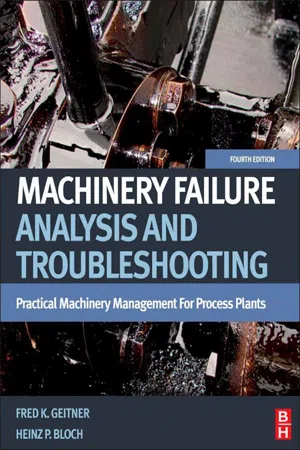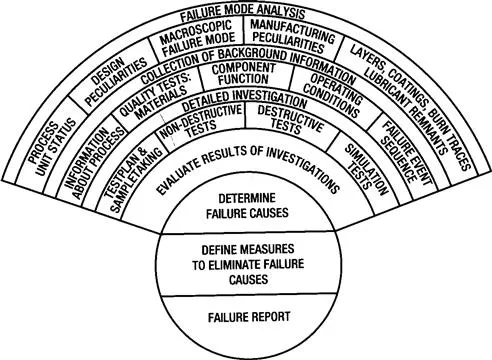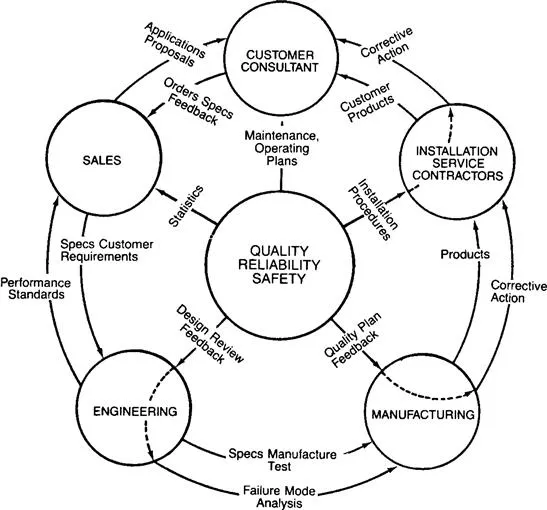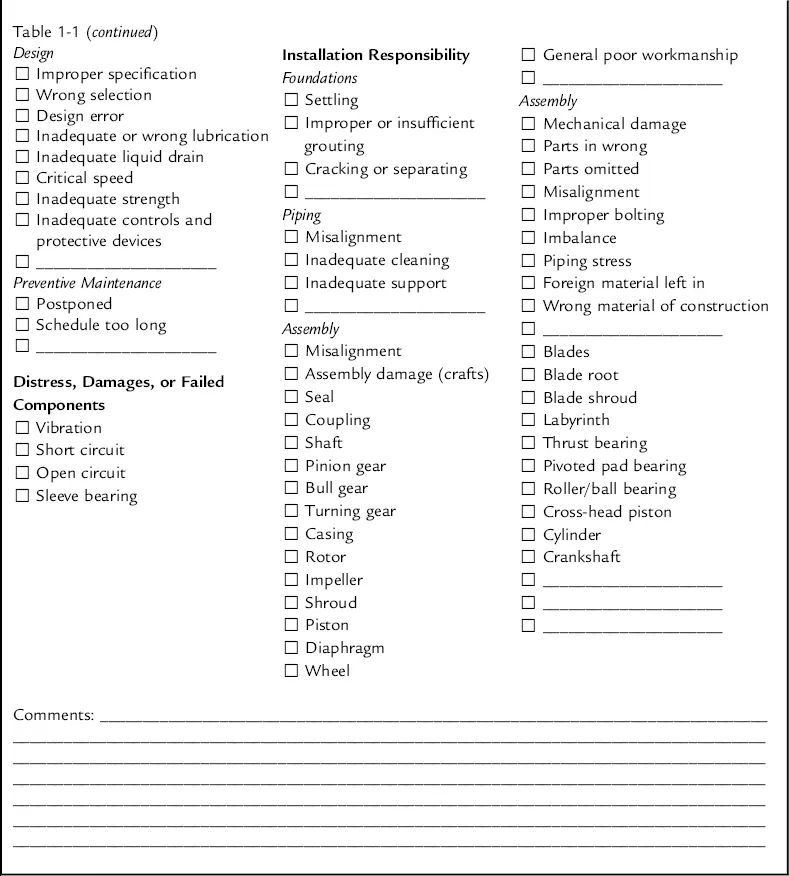
eBook - ePub
Machinery Failure Analysis and Troubleshooting
Practical Machinery Management for Process Plants
- 760 pages
- English
- ePUB (mobile friendly)
- Available on iOS & Android
eBook - ePub
Machinery Failure Analysis and Troubleshooting
Practical Machinery Management for Process Plants
About this book
Solve the machinery failure problems costing you time and money with this classic, comprehensive guide to analysis and troubleshooting
- Provides detailed, complete and accurate information on anticipating risk of component failure and avoiding equipment downtime
- Includes numerous photographs of failed parts to ensure you are familiar with the visual evidence you need to recognize
- Covers proven approaches to failure definition and offers failure identification and analysis methods that can be applied to virtually all problem situations
- Demonstrates with examples how the progress and results of failure analysis and troubleshooting efforts can be documented and monitored
Failures of machinery in a plant setting can have wide-ranging consequences and in order to stay competitive, corporations across all industries must optimize the efficiency and reliability of their machinery.
Machinery Failure Analysis and Troubleshooting is a trusted, established reference in the field, authored by two well-known authorities on failure and reliability. Structured to teach failure identification and analysis methods that can be applied to almost all problem situations, this eagerly awaited update takes in the wealth of technological advances and changes in approach seen since the last edition published more than a decade ago.
Covering both the engineering detail and management theory, Machinery Failure Analysis and Troubleshooting provides a robust go-to reference and training resource for all engineers and managers working in manufacturing and process plants.
- Provides detailed, complete and accurate information on anticipating risk of component failure and avoiding equipment downtime
- Presents documented failure case studies and analyzes the procedures employed to define events that led to component or systems failure
- Includes numerous photographs of failed parts to ensure readers are familiar with the visual evidence they need to recognize
Frequently asked questions
Yes, you can cancel anytime from the Subscription tab in your account settings on the Perlego website. Your subscription will stay active until the end of your current billing period. Learn how to cancel your subscription.
At the moment all of our mobile-responsive ePub books are available to download via the app. Most of our PDFs are also available to download and we're working on making the final remaining ones downloadable now. Learn more here.
Perlego offers two plans: Essential and Complete
- Essential is ideal for learners and professionals who enjoy exploring a wide range of subjects. Access the Essential Library with 800,000+ trusted titles and best-sellers across business, personal growth, and the humanities. Includes unlimited reading time and Standard Read Aloud voice.
- Complete: Perfect for advanced learners and researchers needing full, unrestricted access. Unlock 1.4M+ books across hundreds of subjects, including academic and specialized titles. The Complete Plan also includes advanced features like Premium Read Aloud and Research Assistant.
We are an online textbook subscription service, where you can get access to an entire online library for less than the price of a single book per month. With over 1 million books across 1000+ topics, we’ve got you covered! Learn more here.
Look out for the read-aloud symbol on your next book to see if you can listen to it. The read-aloud tool reads text aloud for you, highlighting the text as it is being read. You can pause it, speed it up and slow it down. Learn more here.
Yes! You can use the Perlego app on both iOS or Android devices to read anytime, anywhere — even offline. Perfect for commutes or when you’re on the go.
Please note we cannot support devices running on iOS 13 and Android 7 or earlier. Learn more about using the app.
Please note we cannot support devices running on iOS 13 and Android 7 or earlier. Learn more about using the app.
Yes, you can access Machinery Failure Analysis and Troubleshooting by Heinz P. Bloch,Fred K. Geitner in PDF and/or ePUB format, as well as other popular books in Technology & Engineering & Mechanical Engineering. We have over one million books available in our catalogue for you to explore.
Information
Chapter 1
The Failure Analysis and Troubleshooting System
Chapter Outline
Troubleshooting as an Extension of Failure Analysis
Causes of Machinery Failures
Root Causes of Machinery Failure
References
Troubleshooting as an Extension of Failure Analysis
For years, the term “failure analysis” has had a specific meaning in connection with fracture mechanics and corrosion failure analysis activities carried out by static process equipment inspection groups. Figure 1-1 shows a basic outline of materials failure analysis steps.1 The methods applied in our context of process machinery failure analysis are basically the same; however, they are not limited to metallurgic investigations. Here, failure analysis is the determination of failure modes of machinery components and their most probable causes. Figure 1-2 illustrates the general significance of machinery component failure mode analysis as it relates to quality, reliability, and safety efforts in the product development of a major turbine manufacturer.2

Figure 1-1 Failure analysis steps—materials technology
(modified from Ref. 1).

Figure 1-2 Failure analysis and the “wheel of quality.”2
Very often, machinery failures reveal a reaction chain of cause and effect. The end of the chain is usually a performance deficiency commonly referred to as the symptom, trouble, or simply “the problem.” Troubleshooting works backward to define the elements of the reaction chain and then proceeds to link the most probable failure cause based on failure (appearance) analysis with a root cause of an existing or potential problem. For all practical purposes, failure analysis and troubleshooting activities will quite often mesh with one another without any clear-cut transition.
However, as we will see later, there are numerous cases where troubleshooting alone will have to suffice to get to the root cause of the problem. These are the cases that present themselves as performance deficiencies with no apparent failure modes. Intermittent malfunctions and faults are typical examples and will tax even the most experienced troubleshooter. In these cases, troubleshooting will be successful only if the investigator knows the system he is dealing with. Unless he is thoroughly familiar with component interaction, operating or failure modes, and functional characteristics, his efforts may be unsuccessful.
There are certain objectives of machinery failure analysis and troubleshooting:
1. Prevention of future failure events.
2. Assurance of safety, reliability, and maintainability of machinery as it passes through its life cycles of:
a. Process design and specification.
b. Original equipment design, manufacture, and testing.
c. Shipping and storage.
d. Installation and commissioning.
e. Operation and maintenance.
f. Replacement.
From this it becomes very obvious that failure analysis and troubleshooting are highly co-operative processes. Because many different parties will be involved and their objectives will sometimes differ, a systematic and uniform description and understanding of process machinery failure events is important.
Causes of Machinery Failures
In its simplest form, failure can be defined as any change in a machinery part or component which causes it to be unable to perform its intended function satisfactorily. Familiar stages preceding final failure are “incipient failure,” “incipient damage,” “distress,” “deterioration,” and “damage,” all of which eventually make the part or component unreliable or unsafe for continued use.
Meaningful classifications of failure causes are:
1. Faulty design.
2. Material defects.
3. Processing and manufacturing deficiencies.
4. Assembly or installation defects.
5. Off-design or unintended service conditions.
6. Maintenance deficiencies (neglect, procedures).
7. Improper operation.
All statistics and references dealing with machinery failures, their sources and causes, generally use these classifications. And, as will be shown in Chapter 4, remembering these seven classifications may be extremely helpful in failure analysis and troubleshooting of equipment.
For practical failure analysis, an expansion of this list seems necessary. Table 1-1 shows a representative collection of process machinery failure causes. The table makes it clear that failure causes should be allocated to areas of responsibilities. If this allocation is not made, the previously listed objectives of most failure analyses will probably not be met.
Table 1-1 Causes of Failures


Failure causes are usually determined by relating them to one or more specific failure modes. This becomes the central idea of any failure analysis activity. Failure mode (FM) in our context is the appearance, manner, or form in which a machinery component or unit failure manifests itself. Table 1-2 lists the basic failure modes encountered in 99 percent of all petrochemical process plant machinery failures.
Table 1-2 Machinery Failure Mode Classification
| Deformation—i.e. plastic, elastic, etc. |
| Fracture—i.e. cracks, fatigue fracture, pitting, etc. |
| Surface changes—i.e. hairline cracks, cavitation, wear, etc. |
| Material changes—i.e. contamination, corrosion, wear, etc. |
| Displacement—i.e. loosening, seizure, excessive clearance, etc. |
| Leakage |
| Contamination |
In the following sections, this list will be expanded so that it can be used for day-to-day failure analysis. Failure mode should not be confused with failure cause, as the former is the effect and the latter is the cause of a failure event. Failure mode can also be the result of a long chain of causes and effects, ultimately leading to a functional failure, i.e. a symptom, trouble, or operational complaint pertaining to a piece of machinery equipment as an entity.
Other terms frequently used in the preceding context are “kind of defect,” “defect,” or “failure mechanism.” The term “failure mechanism” is often described as the metallurgical, chemical, and tribological process leading to a particular failure mode. For instance, failure mechanisms have been developed to describe the chain of cause and effect for fretting wear (FM) in roller bearing assemblies, cavitation (FM) in pump impellers, and initial pitting (FM) on the surface of a gear tooth, to name a few. The basic agents of machinery component and part failure mechanisms are always force, a reactive environment, time and temperature. Thi...
Table of contents
- Cover image
- Title page
- Table of Contents
- Copyright
- Dedication
- Acknowledgments
- Preface
- Chapter 1. The Failure Analysis and Troubleshooting System
- Chapter 2. Metallurgical Failure Analysis
- Chapter 3. Machinery Component Failure Analysis
- Chapter 4. Machinery Troubleshooting
- Chapter 5. Vibration Analysis
- Chapter 6. Generalized Machinery Problem-Solving Sequence
- Chapter 7. Statistical Approaches in Machinery Problem Solving
- Chapter 8. Formalized Failure Reporting as a Teaching Tool
- Chapter 9. The “Seven Cause Category Approach” to Root-Cause Failure Analysis
- Chapter 10. A Principle Based Problem Solving Process
- Chapter 11. Knowledge-Based Systems for Machinery Failure Diagnosis
- Chapter 12. Training and Organizing for Successful Failure Analysis and Troubleshooting
- APPENDIX A: Databases, Surveys and mean-time-between-failure expectations derived from literature and from authors’ observations
- APPENDIX B: Probability Plotting of Life Data
- APPENDIX C: Glossary of Problem-Solving and Decision-Making Terms
- APPENDIX D: Gear Nomenclature
- Subject Index